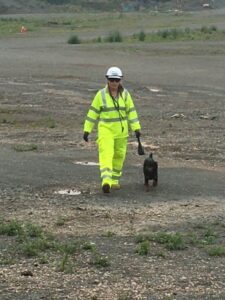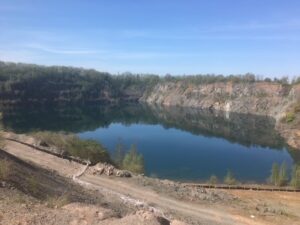Training one of our working dogs to locate ground birds
Ground Nesting Birds
Ground nesting birds on sites earmarked for development can cause delays and incur high costs.
All wild birds, their eggs and nests are protected by law, this means that once a nest is established an exclusion zone of 50-100 metres is needed around the nest. This can cause significant problems for companies with scheduled work to complete in areas where ground nesting birds have settled.
Our goal is to ensure that the ground nesting birds have a place to nest that will not interfere with scheduled works, we do this by identifying local areas that would be more suitable for ground nesting birds to settle. With our team working with trained working dogs from sunrise to sunset we can encourage ground nesting birds to create nests in the alternative nesting sites.
In conjunction with this, we identify hotspots of ground nesting bird activity and use our bird of prey team to further dissuade ground nesting birds from settling there. This is another measure to ensure that the ground nesting birds view the alternative nesting sites as a safer place to nest and raise their young.
Bird Control
Bird control services in Northamptonshire, Bedfordshire,Milton Keynes and surrounding areas
Falconry is a natural method of control and is an effective control method where proofing is not practical, such as a large open area or where your building is listed and proofing cannot be installed. Other methods such as audio deterrents and visual deterrents, such as hawk kites, can compliment a bird control program but used alone, birds quickly habituate to them and they can become ineffective. We also use dog patrols as another means of bird control to deter ground nesting birds which can cause expensive delays to property developments.
Call us to arrange your free survey and risk assessment today on 07775 713300 or email info@birdandpest.co.uk
Pest Control
Providing a full range of pest control services to both the commercial and domestic markets.
The first consideration for pest control should always be prevention, followed by proofing and then control if needed.
Bird and Pest.co.uk technicians are trained to offer practical advice in order to anticipate problems before they arise, saving the client money and reducing the amount of chemicals being used.
Commercial Pest Control
This is normally in the form of an annual contract although we do also operate a call out service to commercial customers. Depending on the individual site the frequency of visits can range from weekly to once every 4 months. A typical rodent contract would cover rats and mice. Other services such as ants, wasps, cockroaches and flies can also be covered.
Domestic Pest Control
All the common pests are covered, from wasps to moles and can normally give an immediate quotation over the phone; our aim is to deal with any problems within 24hrs.
Bird Proofing
Bird and Pest.co.uk carry out all types of proofing from small scale spiking to netting a whole factory roof.
We can also use a speciality rope access team for proofing areas where it is not possible to use traditional access equipment.
Netting
Netting is normally used to exclude birds from large areas such as roofs or courtyards and canopies. Nets can also be installed vertically on buildings where there are multiple perching and roosting points, such as decorative features. Vertical nets can also be used on buildings such as a block of flats with small balconies in order enclose the balcony to prevent access by birds. Nets can be used to exclude any size of birds from sparrows to pigeons to seagulls.
Spikes
These tend to be used on ledges, gutters and roof edges. They are very effective but can be obtrusive, but they are an economical form of proofing.
Bird Wire – this is less obtrusive than spikes but can be used in similar situations, provided that there is not a heavy infestation.
Bird Gel
A relatively new product. We have been using it as a pigeon deterrent since 2010 and it has proved to be very effective on areas such as ledges. It is rarely visible from the ground and is a good option where aesthetics are important.
Avishock – an electric bird deterrent system used extensively on heritage sites, due to its low profile (8mm). It is very discrete and can be used on all types of surface and for all levels of infestation. It runs from an energiser similar to an electric fence – a low maintenance system.
For a free survey and advice please contact Bird and Pest.co.uk on 07775713300 or 01327 358623.
Guano Cleaning
Bird fouling (guano) can affect your business in a number of ways. There is a duty of care to staff, occupants, tradesmen and visitors who may be put at risk.
Health and safety risks
Large amounts of guano should be considered a serious health hazard.
Bird fouling contains many diseases which can be passed to humans. These diseases include: Chlamydiosis, Ornithosis, Psittacosis, Cryptococosis, Campylobactor, Salmonellosis, Extrinsic Allergic Alveolitis – also known as Pigeon fancier’s lung, Erysipelas, Escherichia Coli and Histoplasmosis. All of which are a serious hazard to human health.
In addition, fouling can cause a dangerous slip hazard and particular attention should be paid to fire exits and fire escapes where this could impede a safe exit I the event of a fire.
Bird fouling can cause an infestation of biting insects.
Insects will breed in the fouling and then, when the bird infestation is removed, look for a new warm blooded host, transferring bacteria and viruses from the droppings directly into the hosts’ bloodstream. Many insect infestations are a result of nesting materials and guano.
Damage to structure
Bird fouling is acid in nature and can cause damage to the fabric of your building and staining. There is also a risk of water ingress due to fouling and nesting materials blocking gullies and hoppers.
Bird fouling is unsightly
Unsightly guano will impact on your businesses image and reputation.
Treatment and removal
Due to the serious health risks associated with bird fouling. Large amounts require specialist treatment and removal. Bird and Pest.co.uk have vast experience treating and removing fouling from all types of businesses and buildings. Trained technicians wearing correct PPE will treat the affected area throughout the process; the guano is then carefully removed from site and disposed of as treated waste.
Falconry Response
Falconry is a natural method of bird control and can be effective where proofing is not practical
The principle of using falconry for bird control is for the bird of prey to act as a deterrent to the pest birds.
After a free site survey Bird and Pest.co.uk will tailor a bird control program to provide a solution to your pest bird issues. Our trained birds of prey provide an effective visual deterrent. The regular presence of a live bird of prey, such as a hawk or falcon is aimed to change the behaviour of the pest birds and render the environment unsafe for them and encouraging them to seek an alternative site.
Falconry is a natural method of control and is an effective control method where proofing is not practical, such as a large open area or where your building is listed and proofing cannot be installed. Other methods such as audio deterrents and visual deterrents, such as hawk kites, can compliment a bird control program but used alone, birds quickly habituate to them and they can become ineffective. We also use dog patrols as another means of bird control to deter ground nesting birds which can cause expensive delays to property developments.
This is very different to the sport of falconry where the aim is for the bird of prey to catch their quarry. When birds of prey are being used as a deterrent the objective is to establish an area where the pest birds feel threatened by the presence of the hawk without actually being caught, and so move to a safer area.
Pigeon Deterrent
Hawks are generally used to deter pigeons in urban areas such as town centres, schools and hospitals where large scale proofing would be prohibitively expensive.
Seagull Deterrent
Hawks or falcons can be used to deter seagulls. With large, open areas such as horse studs or landfill sites, falcons would normally be used. In industrial areas such as food production factory sites, shopping centres and schools, hawks would be used.
Ground Nesting Birds
Birds of prey can be used to deter ground nesting birds from areas earmarked for development. The bird of prey is flown in the area before the birds start to build their nests so that they move to a safer nesting site nearby.
Warehouses
Birds of prey can be used to chase a bird out of a large commercial building.
Development Sites
Along with proofing measures, birds of prey can be used to deter birds from nesting in or around buildings due for re-development.
Egg and Nest Removal
Seagulls can nest on large roofs. Falconry can be used to disrupt the birds prior to nesting, but it may also be necessary to adopt an egg and nest removal programme over a number of years to reduce the overall breeding population.



Follow Us!